The year 2025 is here, and the world of social media is moving faster than ever. It’s a place of constant change, with new platforms, evolving algorithms, and a whole new set of rules for engagement. For business owners and marketers, this can feel a bit overwhelming. You know you need to be on social media, but how do you create a plan that doesn’t just get you likes and followers, but actually gets you customers and sales?
A strong social media plan isn’t about luck or just posting funny memes. It’s a clear plan that links your daily social media work to your larger business goals. It’s the difference between a brand that merely exists online and one that thrives. A thriving brand turns followers into loyal customers.
This guide is your simple plan for creating a social media marketing strategy. It’s ready for 2025 and aims to deliver real, measurable results. We’ll break down the key steps, from setting the right goals to creating content that people actually want to see. By the end, you’ll have a clear, easy-to-follow plan that works for you. Let’s get started on turning your social media presence into a powerful engine for growth.
Step 1: Lay the Foundation by Setting SMART Goals
Before you post a single thing, you need to know what you’re trying to achieve. Without clear goals, you’re just throwing content out into the digital world and hoping something sticks. In 2025, a successful social media plan starts with setting SMART goals. This is a classic framework, but it’s more important than ever because it gives your social media efforts a clear purpose.
- S – Specific: Don’t just say, “I want to get more followers.” That’s too vague. Be specific. For example, “I want to increase our Instagram follower count by 15% in the next quarter by running a contest and posting more Reels.” This gives you a clear target and a plan to reach it.
- M – Measurable: How will you track your progress? Your goals need to have a number attached to them. Instead of “get more website traffic,” try “drive 200 new website visitors from Facebook each month.” This makes it easy to see if you are on track or if you need to change your approach.
- A – Achievable: Is your goal realistic? It’s great to dream big, but an impossible goal will only lead to frustration. Base your goals on your current performance and available resources. For instance, if you currently get 5 website clicks a month from social media, aiming for 500 might be too big a leap. Start with a more realistic goal like 50.
- R – Relevant: Does this goal matter to your business? Your social media marketing goals should match your main business aims. This could mean boosting sales, raising brand awareness, or enhancing customer service. A social media goal of “getting 1,000 likes on a post” might not be relevant if your main goal is to get more sales.
- T – Time-bound: Set a deadline. Give yourself a specific date to reach your goal. For instance, “increase our sales from Instagram by 10% by the end of Q3 2025.” A deadline creates a sense of urgency and helps you stay focused.
When you set your goals this way, you create a clear target. You’ll know exactly what you’re working toward, and you’ll have a way to measure your success. This is the first and most critical step to creating a plan that actually converts.
Step 2: Know Your Audience Inside and Out
You can’t create content that converts if you don’t know who you’re talking to. In 2025, social media is all about connection, and you can only connect with people if you understand them. This is more than just knowing their age and location. It’s about knowing their pain points, their dreams, and what makes them laugh.
To truly understand your audience, you need to do some research.
- Create Audience Personas: Build a detailed profile of your ideal customer. Give them a name, a job, and a backstory. What are their challenges? What do they do for fun? What kind of content do they like to see online? You could create a persona named “Sarah.” She is a 32-year-old small business owner. Sarah loves quick tips for marketing. She also struggles to find time to post on social media.
- Use Social Media Analytics: Dive into the analytics tools on each platform you use (Facebook Insights, Instagram Analytics, TikTok Creator Center, etc.). These tools give you a ton of information about your current followers, including their age, where they live, and when they are most active online. This data is invaluable because it tells you what is already working with your audience.
- Listen to Conversations: Use social listening tools. They help you see what people say about your brand, your industry, and your competitors. What questions are they asking? What problems are they trying to solve? This is invaluable information for creating content that is genuinely helpful and relevant. This also helps you find trends and topics to talk about before they get too popular.
In 2025, authenticity and relatability are top priorities for consumers. They want to buy from brands they trust. When you truly know your audience, you can craft content just for them. This helps build trust and loyalty. Trust and loyalty are key for conversions.
Step 3: Choose Your Platforms and Optimize Them
You don’t have to be on every single social media platform. In fact, trying to manage too many channels can spread you too thin and dilute your message. The key is to be present and active where your target audience spends their time.
- Find Your Audience: Go back to your audience research from Step 2. Where are they most active? If you’re a B2B business, LinkedIn might be a great choice. If you sell fashion or beauty products, Instagram and TikTok are likely where you need to be. If you’re a local business, Facebook is still a powerful tool for community engagement.
- Quality Over Quantity: It’s better to have a strong presence on two or three platforms than a weak presence on five. Choose the platforms where you can truly invest your time and energy. Each platform has its own rules and culture, and you need to be able to adapt to them. A great video on TikTok might not work as well on LinkedIn.
- Optimize Your Profiles: Make sure every social media profile is a consistent reflection of your brand. Use the same profile picture and cover photo. Your bio should be clear, concise, and include a link to your website or a relevant landing page. This link is your chance to drive traffic and convert visitors, so use it wisely. On Instagram, for example, your bio link is your most valuable real estate. Use a tool like Linktree if you need to link to multiple places.
Step 4: Create a Winning Content Strategy for 2025
Content is the heart of your social media plan. But in 2025, the content landscape is changing. Here’s what you need to focus on to create content that not only gets attention but also drives conversions:
The Power of Short-Form Video
Video is still king, and short-form video is dominating. Platforms like TikTok, Instagram Reels, and YouTube Shorts are where people are spending most of their time. These videos are not just for entertainment; they are now a primary tool for discovery and search.
- Be Authentic: Your short-form videos don’t have to be highly polished. In fact, people often prefer content that feels authentic and real. A video shot on your phone with a good message can often perform better than a professionally produced one. Show behind-the-scenes moments, introduce your team, and show the human side of your brand.
- Teach and Amuse: Use these videos for quick tips, a peek behind the scenes, or to answer common questions. This builds trust and positions you as an expert. For example, a bakery could post a quick Reel showing how to decorate a cake, or a lawyer could post a short video explaining a common legal question.
- Optimize for Search: Many people now use TikTok and Instagram as search engines. So, include relevant keywords in your captions and on-screen text. This helps ensure your content gets found. Use hashtags that are relevant to your industry and what people are searching for.
The Rise of User-Generated Content (UGC)
People trust other people more than they trust brands. That’s why user-generated content is more important than ever. UGC is content made by your customers. This includes reviews, photos of them using your product, and videos sharing their experiences.
- Encourage UGC: Run contests, create branded hashtags, or simply ask your customers to share their photos with you. For example, a coffee shop could run a contest where customers post a picture of their coffee with the hashtag #MyDailyBrew for a chance to win a prize.
- Amplify Your Customers’ Voices: When a customer shares something positive, share it on your own feed. This is a powerful form of social proof that builds trust and loyalty. It shows that real people love your brand, which is a powerful message for new customers.
The 80/20 Rule: Value vs. Promotion
No one wants to follow a brand that only talks about itself. A great content strategy follows the 80/20 rule:
- 80% of your content should be about giving value, educating, and entertaining your audience. This could be a blog post, a helpful tip, or a funny video that relates to your industry.
- 20% of your content can be promotional, talking about your products, sales, and services.
This balance keeps your audience engaged and makes them more receptive when you do have something to sell. It builds a relationship with them first, so when you do make a sales pitch, they are more likely to listen and convert.
Step 5: Master the Art of Community Building and Engagement
In 2025, social media isn’t just a broadcasting tool; it’s a place for conversation. A plan that converts is built on genuine engagement and community. This is where you can build lasting relationships with your customers.
- Engage Like a Human: Respond to comments and DMs quickly and genuinely. Use a conversational tone, not a robotic one. This shows your audience that there’s a real person behind the brand. Ask them questions back and start conversations.
- Go Where the Conversation Is: Don’t just wait for people to come to you. Go out and find conversations happening in your industry. Leave thoughtful comments on other accounts’ posts and participate in relevant discussions. This is a great way to get your brand noticed by people who don’t already follow you.
- Use Private Communities: Public feeds are crowded now. So, people want smaller, private groups. Think about starting a private Facebook Group, a Discord channel, or an Instagram broadcast channel. These options can help you connect better with your loyal fans. These groups can be a great place to get feedback on new products, offer exclusive deals, and build a truly dedicated community.
Step 6: Use Paid Ads to Amplify Your Results
Organic reach is getting harder to achieve, and that’s a reality of social media in 2025. A smart social media plan includes a budget for paid advertising. Paid ads are not just for big businesses; they are a powerful tool to accelerate your growth and reach a wider audience.
- Targeted Advertising: Facebook and Instagram’s ad platforms allow for incredibly detailed targeting. You can show your ads to a specific group of people based on their interests, demographics, and behaviors. This ensures your ad spend is not wasted and is shown to people who are most likely to convert. If you sell hiking gear, target people who:
- Follow hiking pages
- Live near a national park
- Recently searched for hiking boots
- Retargeting Campaigns: A key strategy is to use retargeting. This means showing ads to people who have engaged with your brand. This includes those who visited your website or followed your Instagram page. They are already familiar with you, so they are more likely to convert. If a person adds a product to their cart but doesn’t buy it, you can show them an ad for that same product. This helps remind them to finish their purchase.
- A/B Test Everything: Don’t just run one ad. Test different headlines, visuals, and calls to action to see what gets the best results. A good plan always includes a strategy for testing and optimizing. You might find that a video ad works better than an image ad, or that a different headline gets more clicks. This data-driven approach is how you get the best return on your ad spend.
Step 7: Analyze Your Performance and Adjust Your Plan
Your social media plan is a living document. It should never be a “set it and forget it” kind of thing. In 2025, you need to be constantly looking at your data and adjusting your strategy.
- Track Your KPIs: Go back to the SMART goals you set in Step 1. Are you meeting your goals? Check your key performance indicators (KPIs). These include engagement rate, click-through rate, and conversion rate. Are your ads generating sales? Are your posts driving traffic to your website?
- Use Analytics Tools: Use the native analytics on each platform, as well as third-party tools, to see what’s working and what’s not. Which posts got the most engagement? Which ones drove the most website traffic? This data tells a story about what your audience wants to see.
- Adjust Your Strategy: Based on what you learn, make changes. If your video content is getting a lot of shares, create more videos. If a certain type of post is falling flat, stop doing it. If a specific audience is responding well to your ads, double down on that audience. This data-driven approach is how you ensure your plan is always converting at its highest potential.
Conclusion: Your 2025 Social Media Success Awaits
Creating a social media marketing plan that converts in 2025 is about being strategic and intentional. It’s about more than just being present; it’s about being purposeful. Follow these steps: set clear goals, know your audience, create great content, and use data to guide decisions. This way, you can build a plan that works.
Remember, the goal is not to have the biggest follower count. The goal is to build a community, create genuine connections, and ultimately, grow your business. The tools and trends may change, but this fundamental approach to social media will always deliver results. Now, go and build your plan, and get ready to see your efforts pay off.
FAQs about Social Media Marketing Plans
Q1: How often should I post on social media?
A: This depends on the platform and your audience. A good starting point is to post at least once a day on most platforms. However, quality is more important than quantity. It’s better to post a high-quality piece of content three times a week than a low-quality piece every day. Use analytics to see when your audience is most active and post then.
Q2: What is the most important social media metric to track?
A: The most important metric is the one that is most relevant to your business goals. For an e-commerce store, it might be sales or return on ad spend (ROAS). For a service-based business, it might be lead generation. While likes and comments are nice, they are “vanity metrics” if they aren’t leading to your ultimate business goals.
Q3: How much money should I spend on social media ads?
A: There is no single answer, but a good starting point for a small business is to set aside a budget of $500 to $1,000 per month for ad spend. This gives you enough money to run a few targeted campaigns and gather enough data to see what works. As you start to see a good return on your investment, you can increase your ad budget.
Q4: Is it better to create my own content or use user-generated content (UGC)?
A: The best strategy is to use a mix of both. Creating your own high-quality content helps to build your brand identity and showcase your products or services. Using UGC is a powerful way to build trust and social proof, as it shows that real people love your brand. A good social media plan will incorporate both.
Q5: Should I hire a social media manager or do it myself?
A: If you are a small business owner just starting out, you can absolutely do it yourself. As your business grows, your social media needs get more complex. So, hiring a social media manager or an agency can be a wise investment. A professional can save you a lot of time and help you get much better results because they are experts in the field.


